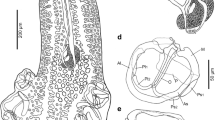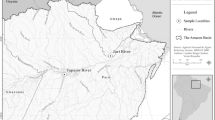Abstract
Five new species of dicyemid mesozoans in two genera are described from two Australian cuttlefish species, Sepia apama Gray (giant Australian cuttlefish) and S. novaehollandiae Hoyle (nova cuttlefish): Dicyema coffinense n. sp. from S. apama collected from Coffin Bay, South Australia (SA), Australia; D. koinonum n. sp. from S. apama and S. novaehollandiae collected from Gulf St Vincent (GSV) and Spencer Gulf (SG), SA, Australia; D. multimegalum n. sp. from S. apama collected from Cronulla and North Bondi, New South Wales, Australia; D. vincentense n. sp. from S. novaehollandiae collected from GSV, SA, Australia; and Dicyemennea spencerense n. sp. from S. novaehollandiae and S. apama collected from SG, SA, Australia. Totals of 51 S. apama and 27 S. novaehollandiae individuals were examined, of which all except for four S. apama were infected by at least one dicyemid species. Dicyemid parasites were also observed in host individuals that were held in tanks for 2–3 months prior to examination, including nematogen-exclusive infections, leading to questions about persistence of dicyemids after host death and the mechanism responsible for the switch between a nematogen phase and a rhombogen phase. Variations in host size, calotte shape and collection locality are explored as predictors of differences in observed composition of the parasite fauna. In particular, dicyemid parasite fauna varied with host collection locality. As these parasites are highly host-species specific, their use as biological tags to assess cephalopod population structure using a combined morphological and molecular approach is discussed. This study increases the number of dicyemid species described from Australian cephalopods from five to ten, and from 117 to 122 species described worldwide.











Similar content being viewed by others
References
Aruga, J., Odaka, Y. S., Kamiya, A., & Furuya, H. (2007). Dicyemid Pax6 and Zic: tool-kit genes in a highly simplified bilaterian. BMC Evolutionary Biology, 7, 1–16.
Bogolepova-Dobrokhotova, I. I. (1962). Dicyemidae of far-eastern seas II. New species of the genus Dicyemennea. Zoologicheskii Zhurnal, 41, 503–518.
Catalano, S. R. (2012). A review of the families, genera and species of Dicyemida Van Beneden, 1876. Zootaxa, 3479, 1–32.
Catalano, S. R. (2013). First descriptions of dicyemid mesozoans (Dicyemida: Dicyemidae) from Australian octopus (Octopodidae) and cuttlefish (Sepiidae) species, including a new record of Dicyemennea in Australian waters. Folia Parasitologica, 60, 306–320.
Catalano, S. R., & Furuya, H. (2013). Two new species of dicyemid (Dicyemida: Dicyemidae) from two Australian cephalopod species: Sepioteuthis australis (Mollusca: Cephalopoda: Loliginidae) and Sepioloidea lineolata (Mollusca: Cephalopoda: Sepiadariidae). Journal of Parasitology, 99, 203–211.
Criscione, C. D., Cooper, B., & Blouin, M. S. (2006). Parasite genotypes identify source populations of migratory fish more accurately than fish genotypes. Ecology, 87, 823–828.
Finn, J. K., Hochberg, F. G., & Norman, M. D. (2005). Phylum Dicyemida in Australian waters: First record and distribution across diverse cephalopod hosts. Phuket Marine Biology Research Center Bulletin, 66, 83–96.
Furuya, H. (1999). Fourteen new species of dicyemid Mesozoans from six Japanese cephalopods, with comments on host specificity. Species Diversity, 4, 257–319.
Furuya, H. (2008). A new dicyemid from Sepiella japonica (Mollusca: Cephalopoda: Decapoda). Journal of Parasitology, 94, 223–229.
Furuya, H. (2009). Two new dicyemid from Sepia longipes (Mollusca: Cephalopoda: Decapoda). Journal of Parasitology, 95, 681–689.
Furuya, H. (2010). A new dicyemid from Benthoctopus sibiricus (Mollusca: Cephalopoda: Octopoda). Journal of Parasitology, 96, 1,123–1,127.
Furuya, H., & Hochberg, F. G. (1998). Three new species of Dicyema (Phylum Dicyemida) from cephalopods in the western Mediterranean. Vie et Milieu, 49, 117–128.
Furuya, H., & Hochberg, F. G. (2002). New species of Dicyemennea (Phylum: Dicyemida) in deep-water Graneledone (Mollusca: Cephalopoda: Octopoda) from the Antarctic. Journal of Parasitology, 88, 326–330.
Furuya, H., & Tsuneki, K. (2005). A new species of dicyemid mesozoan (Dicyemida: Dicyemidae) from Sepioteuthis lessoniana (Mollusca: Cephalopoda), with notes on Dicyema orientale. Species Diversity, 10, 45–62.
Furuya, H., Tsuneki, K., & Koshida, Y. (1992). Two new species of the genus Dicyema (Mesozoa) from octopuses of Japan with notes on D. misakiense and D. acuticephalum. Zoological Science, 9, 423–437.
Furuya, H., Hochberg, F. G., & Tsuneki, K. (2003a). Calotte morphology in the phylum Dicyemida: Niche separation and convergence. Journal of Zoology, 259, 361–373.
Furuya, H., Hochberg, F. G., & Tsuneki, K. (2003b). Reproductive traits in dicyemids. Marine Biology, 142, 693–706.
Furuya, H., Hochberg, F. G., & Tsuneki, K. (2007). Cell number and cellular composition in vermiform larvae of dicyemid mesozoans. Journal of Zoology, 272, 284–298.
Furuya, H., Ota, M., Kimura, R., & Tsuneki, K. (2004). Renal organs of cephalopods: A habitat for dicyemids and chromidinids. Journal of Morphology, 262, 629–643.
Gonzalez, A. F., Pascual, S., Gestal, C., Abollo, E., & Guerra, A. (2003). What makes a cephalopod a suitable host for parasite? The case of Galician waters. Fisheries Research, 60, 177–183.
Guegan, J. F., Lambert, A., Leveque, C., Combes, C., & Euzet, L. (1992). Can host body size explain the parasite species richness in tropical freshwater fishes? Oecologia, 90, 197–204.
Hall, K. C., & Hanlon, R. T. (2002). Principal features of the mating system of a large spawning aggregation of the giant Australian cuttlefish Sepia apama (Mollusca: Cephalopoda). Marine Biology, 140, 533–545.
Ho, J. S. (1991). Two species of chondracanthid copepods parasitic on commercial fishes in the Pacific. Publications of the Seto Marine Biological Laboratory, 31, 1–10.
Hochberg, F. G. (1982). The “kidneys” of cephalopods: A unique habitat for parasites. Malacologia, 23, 121–134.
Hochberg, F. G. (1983). The parasites of cephalopods: A review. Memoirs of the National Museum Victoria, 44, 108–145.
Hochberg, F. G. (1990). Diseases caused by protists and mesozoans. In: Kinne, O. (Ed) Diseases of Marine Animals, Volume III. Hamburg, Germany: Biologische Anstalt Helgoland, pp. 47–202.
Kalavati, C., Narasimhamurti, C. C., & Suseela, T. (1984). Four new species of mesozoan parasites (Mesozoa: Dicyemidae) from cephalopods of Bay of Bengal. Proceedings of the Indian Academy of Science (Animal Science), 93, 639–654.
Kassahn, K. S., Donnellan, S. C., Fowler, A. J., Hall, K. C., Adams, M., & Shaw, P. W. (2003). Molecular and morphological analyses of the cuttlefish Sepia apama indicate a complex population structure. Marine Biology, 143, 947–962.
Katayama, T., Wada, H., Furuya, H., Satoh, N., & Yamamoto, M. (1995). Phylogenetic position of the dicyemid Mesozoa inferred from 18S rDNA sequences. Biological Bulletin, 189, 81–90.
Kearn, G. C. (1967). Experiments on host-finding and host-specificity in the monogenean skin parasite Entobdella soleae. Parasitology, 57, 585–605.
Kobayashi, M., Furuya, H., & Holland, P. W. H. (1999). Dicyemids are higher animals. Nature, 401, 762.
Kobayashi, M., Furuya, H., & Wada, H. (2009). Molecular markers comparing the extremely simple body plan of dicyemids to that of lophotrochozoans: insight from the expression patterns of Hox, Otx, and brachyury. Evolution and Development, 11, 582–589.
Lapan, E. A., & Morowitz, H. J. (1972). The Mesozoa. Scientific American, 227, 94–101.
Lapan, E. A., & Morowitz, H. J. (1974). Characterization of mesozoan DNA. Experimental Cell Research, 83, 143–151.
McConnaughey, B. H. (1949a). Dicyema sullivani, a new mesozoan from lower California. Journal of Parasitology, 35, 122–124.
McConnaughey, B. H. (1949b). Mesozoa of the family Dicyemidae from California. University of California Publications in Zoology, 2, 1–33.
McConnaughey, B. H. (1951). The life cycle of the dicyemid mesozoa. University of California Publications in Zoology, 55, 295–336.
McConnaughey, B. H. (1960). The rhombogen phase of Dicyema sullivani McConnaughey (Mesozoa: Dicyemidae). Journal of Parasitology, 46, 608–610.
Norman, M., Finn, J., & Tregenza, T. (1999). Female impersonation as an alternate reproductive strategy in giant cuttlefish. Proceedings of the Royal Society of London, 266, 1,347–1,349.
Noto, T., & Endoh, H. (2004). A “chimera” theory on the origin of dicyemid mesozoans: Evolution driven by frequent lateral gene transfer from host to parasite. BioSystems, 73, 73–83.
Nouvel, H. (1948). Les dicyémides II. Infusoriforme, tératologie, spécificité du parasitisme, affinités. Archives de Biologie, 59, 147–224.
Ogino, K., Tsuneki, K., & Furuya, H. (2010). Unique genome of dicyemid mesozoan: Highly shortened spliceosomal introns in conservative exon/intron structure. Gene, 449, 70–76.
Ohama, T., Kumazaki, T., Hori, H., & Osawa, S. (1984). Evolution of multicellular animals as deduced from 5S rRNA sequences: A possible early emergence of the Mesozoa. Nucleic Acids Research, 12, 5,101–5,108.
Pascual, S., & Hochberg, F. G. (1996). Marine parasites as biological tags of cephalopod hosts. Parasitology Today, 12, 324–327.
Pawlowski, J., Montoya-Burgos, J., Fahrni, J. F., Wuest, J., & Zaninetti, L. (1996). Origin of the Mesozoa inferred from 18S rRNA gene sequences. Molecular Biology and Evolution, 13, 1128–1132.
Penchaszadeh, P. E. (1968). Diciemidos (Mesozoa) en cefalopodos de Argentina Dicyema australis sp. nov. parasito del pulpo Octopus tehuelchus D’Orb. Neotropica, 14, 127–131.
Pickford, G. E., & McConnaughey, B. H. (1949). The Octopus bimaculatus problem: A study in sibling species. Bulletin of Bingham Oceanographic College, Peabody Museum of Natural History, Yale University, 12, 1–66.
Poulin, R. (1997). Species richness of parasite assemblages: Evolution and patterns. Annual Review of Ecology and Systematics, 28, 341–358.
Reid, A., Jereb, P., & Roper, C. F. E. (2005). Family Sepiidae. In: Jereb, P. & Roper, C. F. E. (Eds.), Cephalopods of the world. An annotated and illustrated catalogue of species known to date. Volume 1. Chambered nautiluses and sepioids (Nautilidae, Sepiidae, Sepiolidae, Sepiadariidae, Idiosepiidae and Spirulidae). Rome: Food and Agriculture Organisation of the United Nations, pp. 57–152.
Short, R. B., & Damian, R. T. (1966). Morphology of the infusoriform larva of Dicyema aegira (Mesozoa: Dicyemidae). Journal of Parasitology, 52, 746–751.
Suzuki, T. G., Ogino, K., Tsuneki, K., & Furuya, H. (2010). Phylogenetic analysis of dicyemid mesozoans (Phylum Dicyemida) from innexin amino acid sequences: Dicyemids are not related to Platyhelminthes. Journal of Parasitology, 96, 614–625.
van Beneden, E. (1876). Recherches sur les Dicyemides, survivants actuels d’un embranchement des Mésozoaires. Bulletins de l’Academis Royale Des Sciences et Belles Lettres de Bruxelles, 41, 1160–1205.
von Kölliker, A. (1849). Ueber Dicyema paradoxum, den Schmarotzer der Venenanhänge der Cephalopoden [in German]. Berichte von der Königlichen Zootomischen Anstalt zu Wurzburg, 59–66.
Whitman, C. O. (1883). A contribution to the embryology, life-history and classification of the dicyemids. Mittheilungen Zoologischen Station Zu Neapel, 4, 1–90.
Acknowledgements
I thank Kate Hutson, Richard Saunders, Brian Saunders and Kieran Brazell for assistance in sample collections from Coffin Bay, and Bernadette Saunders for keeping us all well nourished! Thanks are due to Cameron Dixon and Graham Hooper at the South Australian Research and Development Institute for organising prawn trawl survey trips in Spencer Gulf and Gulf St Vincent, and to Alex Schnell and Dave Barker for material from New South Wales and allowing me to visit the Cronulla Fisheries Research Centre. All research was conducted with approval from the University of Adelaide Animal Ethics Committee (# S-2010-116) and according to Primary Industries and Resources SA S115 Ministerial Exemptions (# 9902264 and # 9902398). Funding for this project has been provided by the Australian Society for Parasitology, Norman Wettenhall Foundation, Holsworth Wildlife Research Endowment, Sir Mark Mitchell Research Foundation, Lirabenda Endowment Fund, Nature Foundation South Australia, Nature Conservation Society of South Australia and Australian Federation of University Women South Australia. I am grateful to my supervisors Bronwyn Gillanders (University of Adelaide, UA), Steve Donnellan (The South Australian Museum, SAMA, and UA) and Ian Whittington (SAMA and UA) for their constructive comments on earlier drafts, and thanks are due to Tim Benson for his continual support. SRC is funded by an Australian Postgraduate Award.
Author information
Authors and Affiliations
Corresponding author
Rights and permissions
About this article
Cite this article
Catalano, S.R. Five new species of dicyemid mesozoans (Dicyemida: Dicyemidae) from two Australian cuttlefish species, with comments on dicyemid fauna composition. Syst Parasitol 86, 125–151 (2013). https://doi.org/10.1007/s11230-013-9443-6
Received:
Accepted:
Published:
Issue Date:
DOI: https://doi.org/10.1007/s11230-013-9443-6




